Part 1 of this article, Apollo and Daphne: A Tale of Cupid’s Revenge told by Ovid and Bernini, focuses on the Apollo and Daphne story in the Roman poet Ovid’s Metamorphoses (8 A.D.) as it relates to Gian Lorenzo Bernini’s marble sculpture (1622-25). This article — in celebration of Valentine’s Day — is a chronological sampling of Apollo and Daphne images from different times and places, ranging from antiquity to 20th-century fantasies. Watch Apollo strike out across two millennia in works both famous and obscure. New twists and turns are injected into the myth in the 20th and 21st centuries.
Part 1 examined depictions of Apollo and Daphne by Pollaiuolo, Schiavone, Albani, Bernini, Poussin, Cecco Bravo, Houasse, and Boucher. This article emphasizes ancient and modern examples. Attempts to identify early depictions of the theme are complicated by regional variations and the lack of conventional iconography. By the Roman period, this subject had become very popular.
As Ovid tells it, the god Apollo insulted Cupid and suffered his wrath. Cupid’s alchemical arrows caused Apollo to be obsessed with the nymph Daphne, and caused Daphne to find Apollo repulsive. Daphne’s father, the river god Peneus, turned her into a laurel tree so she could escape Apollo. Apollo — who never recovered from Cupid’s spell — made laurel leaves the emblems of honor and triumph.
Robin Hard, in the Routledge Handbook of Greek Mythology, notes that Eros (Cupid’s Greek name), originally imagined as an abstract power, was anthropomorphized into the beautiful and youthful archer-son of Aphrodite, the goddess of love. The inception of Cupid — as a capricious and chubby infantile archer borne on wings — was largely a Hellenistic invention, a function of that period’s concern with romantic love. (The Hellenistic was the period between the death of Alexander the Great in 323 B.C. and Octavian’s triumph over Anthony and Cleopatra in 31 B.C.) The Romans elaborated this conception of Cupid. Ovid’s Metamorphosis is the earliest surviving Apollo and Daphne narrative that includes Cupid.
Hard points out that the earliest surviving versions of the Daphne tale, none of which are as elaborate as Ovid, are Hellenistic. Parthenius tells us that Daphne, a virgin huntress, was the daughter of a Spartan king. Leukippos, son of the king of Pisa, impersonates a female to get close to her, but a jealous Apollo causes his death; an angry Daphne and her virgin maidens kill Leukippus when his gender is revealed. Apollo moves on Daphne, but she prays to Zeus, who turns her into a laurel. Contrary to Hard, Leukippos is also mentioned by the 2nd century A.D. author Pausanias, but he is otherwise excised from other surviving accounts, which have Daphne transformed (or swallowed up) by her mother the earth (Gaia) or transformed by her father, identified either as the river god Peneus in Thessaly or Ladon in Arcadia or Syria. For several Greek and Roman sources in English translation, see Theoi.com. For a recitation of the tale in Greek by storyteller Evi Gerokosta that depends on Ovid (with English subtitles and discussion), go here.

Attic red figure hydria, detail of Apollo Pursuing a Woman, c. 450-440 B.C., British Museum, London. Photo source: British Museum.
No unambiguous texts or images of the Apollo and Daphne myth survive from the classical period (between the Persian wars in the early 5th century B.C. and the death of Alexander the Great in 323 B.C.). Consequently, this vase does not represent Apollo and Daphne, though it can be regarded as a precursor to a myth that did not yet exist.
In this detail, Apollo is equipped with a bow and quiver, he is crowned with a laurel wreath, and he holds a laurel branch. He reaches out to grasp the woman he is chasing with his left hand. The well-dressed woman looks back and raises her hands in a gesture of dismay. As commentary on the British Museum website notes, we have no means to identify the woman. This is not surprising, since vases were illustrated utensils of a relatively common nature, not iconographic encyclopedias.
This vase is testament, however, to the rapacious nature of Greco-Roman male gods, to the vigorous chase scenes depicted by classical Greek artists, and to the fact that Apollo was emphatically associated with the laurel before the advent of the Daphne myth. (Daphne means laurel in Greek.) Thus we can reject Andrew Marvell’s formulation in his poem The Garden (1681):
Apollo hunted Daphne so,
Only that she might laurel grow;
With respect to the Metamorphosis narrative presented in detail in Part 1, W. S. M. Nicoll points out: “Ovid’s contemporaries would not miss the humour in the idea that the patron of epic and serious poetry should be obliged to abandon his epic pretensions in order to get his hands on a tree which was the symbol of his own poetic craft” (“Cupid, Apollo, and Daphne (Ovid. Met. 1. 452. ff),” The Classical Quarterly, 1980).
Gandharan Dishes (also called palettes or trays)
Two small stone dishes in the Metropolitan Museum of Art’s collection are among the most fascinating and complex ancient objects linked to the Apollo and Daphne myth. Though sometimes still referred to as toilet (cosmetic) trays, they were more likely utilized for ritual offerings of wine. They originated in present-day Pakistan, from a crossroads-of-civilizations melting pot on the Silk Route that was governed successively by rulers from multiple cultures. Alexander the Great’s conquests had brought the classical heritage to this region, and many of these dishes exhibit classical subjects, such as the Drunken Hercules.
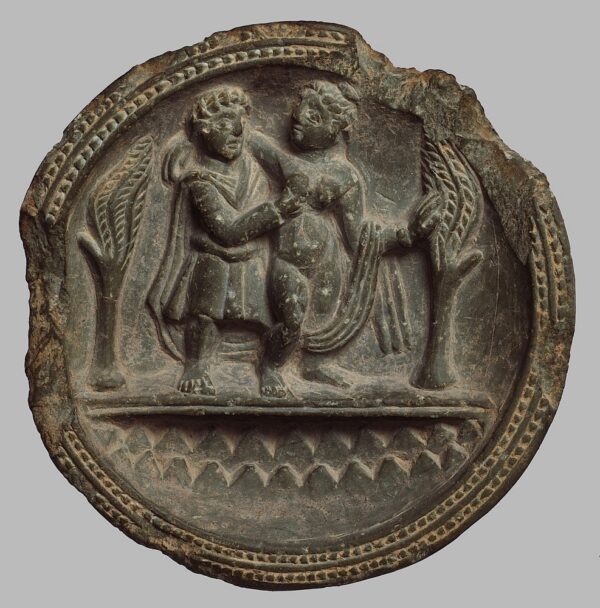
Pakistan (ancient region of Gandhara), Dish with Apollo and Daphne, probably 1st century B.C., schist, 4 3/16 inches in diameter, Metropolitan Museum of Art. Photo source: Metropolitan Museum.
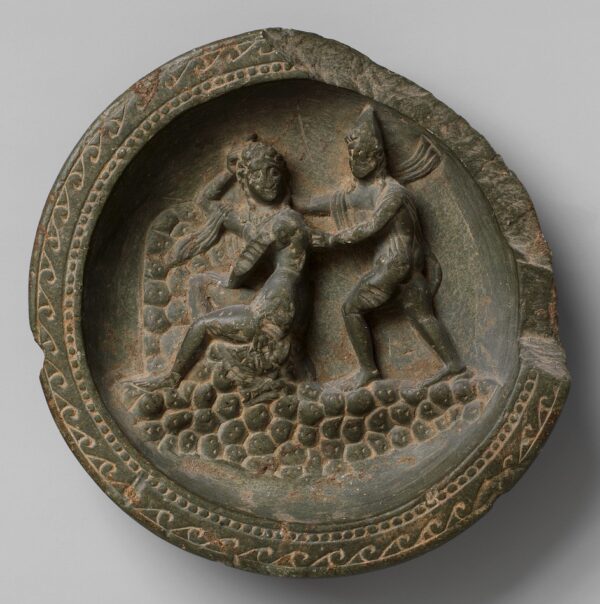
Pakistan (ancient region of Gandhara), Dish with a Mythological Amorous Couple (possibly Apollo and Daphne), probably 1st century B.C., schist, 3 15/16 inches in diameter, Metropolitan Museum of Art. Photo source: Metropolitan Museum.
According to an influential interpretive model, the dishes that possess the most classical traits were assumed to be the earliest (with production beginning in 150 B.C. or slightly earlier) and to predate Buddhist art in Gandhara. In a 2011 article, Ciro Lo Muzio (“Gandharan Toilet-Trays: Some Reflections on Chronology,” Ancient Civilizations from Scythia to Siberia, 2011) reasoned that the Gandharan dishes are primarily of later manufacture than scholars had assumed. His argument is based on G. Erdosy’s reinterpretation of excavations at Sirkap (today’s Taxila, where 32 dishes were found), which holds that most of the Taxila dishes come from strata that date from the 1st or early 2nd century A.D. Extending this finding to works whose original archaeological context is unknown, Lo Muzio argues that most of these dishes are not Hellenistic (Greco-Bactrian or Indo-Greek), nor were they part of a preparatory period during the 2nd and 1st centuries B.C. that preceded and formed a classical bridge to Gandharan Buddhist art.
When the two dishes discussed here were exhibited as part of a large collection that brought them to the Metropolitan Museum, Martin Lerner and Steven Kossak (The Lotus Transcendent: Indian and Southeast Asian Art from the Samuel Eilenberg Collection, 1991) assumed most dishes of this kind were made before Kanishka’s rule (before c. 78 A.D.), under Bactrians, Scythians, Parthians, or Kushans. Lerner and Kossak note that the classical motifs found on Gandharan dishes were utilized in both Hellenistic and Roman eras, and the lack of comparative Indian objects makes them difficult to date. Since, in style and format, these two dishes belong to the earliest Gandharan period, Lerner and Kossak provisionally date them c. 200-90 B.C.
In the Apollo and Daphne dish (I use Lerner and Kossak’s titles), the man’s wreath gives us reason to identify him as Apollo. He touches a naked woman, who has her right arm around the man, while her left arm touches a tree, which is cause to regard her as Daphne. The reverse, which features a wreath, is illustrated on the museum website (where the titles given by Lerner and Kossak are transposed) and in Kurt A. Behrendt, The Art of Gandhara in the Metropolitan Museum of Art (2007).
The subject of the second work, Dish with a Mythological Amorous Couple (possibly Apollo and Daphne), is less securely identifiable. Lerner and Kossak note that the man’s cap is similar to headgear worn by Kushan rulers, a factor that makes it hard to securely date such works. If this is a depiction of Apollo and Daphne, nothing about it is particularly Ovidian: there is no Cupid and no paternal water god, the woman is not running, she is not turning into a tree, and trees are not referenced at all. These absences, however, are not disqualifying because Roman depictions of Apollo and Daphne (discussed below) either follow other accounts, or have few precise correspondences to the details of Ovid’s narrative. Any Hellenistic sources for such a work, of course, would predate Ovid.
Behrendt titles both of these dishes Apollo and Daphne, and he dates them both to the 1st century B.C. He mistakenly assigns the same dimensions and accession number to them. Behrendt illustrates an Egyptian dish from Alexandria (2nd century A.D.) that was found in Cyprus as an example of a class of objects that inspired the Gandharan dishes in style, format, and material. Since the Gandharan dishes are not copies and none depict Egyptian gods, Behrendt characterizes them as adaptations of various foreign prototypes reworked to “suit local needs.”
In his discussion of Dish with a Mythological Amorous Couple (possibly Apollo and Daphne), Behrendt says the pointed Parthian hat situates the scene in “the Greater Gandharan sphere to appeal to a local audience.” He queries whether Greek figures retained their original identities, or if they might have assumed “entirely new or different meanings.” Behrendt raises the possibility that the Apollo and Daphne dish might represent a drunken woman in Dionysian ecstasy. It follows that there might have been syntheses or slippages of subject matter and meaning.
The dishes excavated at Sirkap were found in a domestic context. Lo Mazio thinks their owners, whether they were “Indianised Greeks or Hellenised Sakas” might have been Buddhists. If they were of foreign origin, these dishes could have served to partially preserve “in their private realm a non-Indian mythological and symbolic legacy.” Lo Muzio is uncertain about the function of these dishes, whether “practical, religious or even funerary,” but he thinks most of them are contemporary with early Buddhist monuments. He concludes that the owners of these dishes “should not be thought of as different from the donors who were pleased at seeing, on Gandharan stūpas [temples], reliefs narrating the life of the Buddha framed by Dionysiac drinking scenes.”

Roman, Apollo and Daphne, c. 62-79 A.D., fresco from South wall of Casa dell’Efebo (Domus P. Cornelius Tages) bedroom, Pompeii. Photo source: Buzz Ferebee / Pompeiiinpictures.com
Many frescoes of Apollo and Daphne survive from Pompeii and the environs of Vesuvius. (See Pompeiiinpictures.com for a good selection and for the context in which they were found.) None, however, depict the kind of full-blown, full-flight transformational image based on Ovid that is so familiar from Renaissance, Baroque, and later art (though Lucian refers to one such image). In these Ovidian versions (treated below as well as in Part 1), Daphne sprouts laurel roots and branches while Apollo chases her.
As noted above, Ovid is the earliest surviving account that features Cupid. Moreover, he likely invented the unique detail in which Cupid shoots Daphne with an arrow that makes her despise Apollo, which causes her to flee as soon as she sees him. (See Bronwen Wickkiser, “Cupid’s Arrows: Lead, Gold, Magic and Medicine in Ovid, Met. 1.452-567,” Mnemosyne, 2018.)
Therefore, images that do not depict a chase, such as the example from the Casa dell’Efebo illustrated above, are not in strict conformity with Ovid’s version of the story. Here Daphne appears to be performing a strip tease, while a seated Apollo holds a sprig of laurel. Such frescoes (likely copied from pattern books that might reflect well-known paintings) could derive from other literary versions of the myth. Peter E. Knox, in his article “In Pursuit of Daphne” (Transactions of the American Philological Association, 1990), argues that the dominant pre-Ovid narrative featured a substitution rather than a metamorphosis: Daphne was swallowed up by her mother the earth, and Apollo was presented with the laurel tree as a substitute.
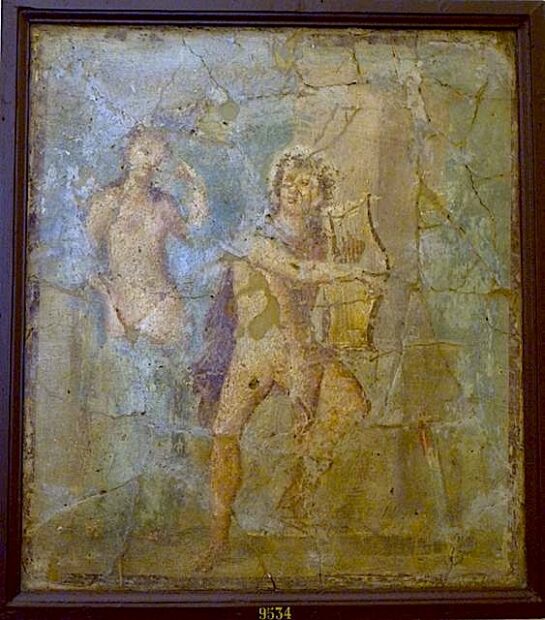
Roman, Apollo and Daphne, c. 62-79 A.D., fresco from the Casa di Meleagro, 56 x 49 cm, Naples, National Archaeological Museum. Photo source: Pinterest.
In this fresco from the Casa di Meleagro, Apollo plays his lyre for a half-naked woman. This fresco and other similar ones are commonly identified as depictions of Apollo and Daphne, though they too lack specifically Ovidian elements. Knox points out that at least five Campanian homes feature frescoes of Apollo serenading an indifferent Daphne. Only three, on the other hand, show a sprig of laurel growing from her body. He illustrates one from Pompeii’s Casa dei Capitelli Colorati, in which Daphne points to her head, which has a sprig of laurel growing from it.
Knox posits a lost account of the story in which “Apollo first attempts to woo the maiden with song before he becomes violent.” Knox believes a version of the tale featuring a “Song of Apollo” was known to Nonnus of Panopolus, the 5th century A.D. Greek epic poet of Egypt, and also to the Roman poet Virgil. Though Ovid eliminates Apollo’s song, Knox points out that he “incorporates the themes appropriate to it into a speech on the run.” Ovid presents courtship as a chase in which, quite comically, the god of eloquence can’t get his beloved to stop and listen to him.
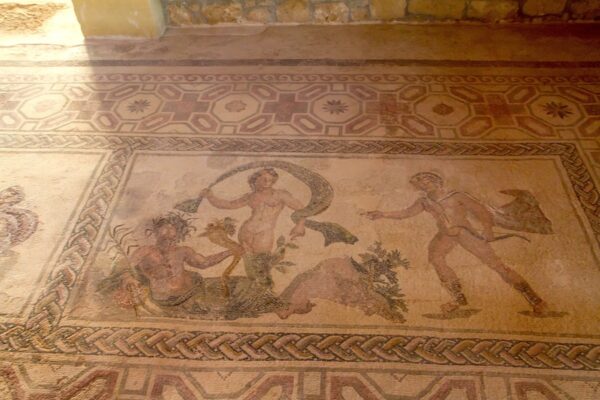
Roman culture, Apollo and Daphne Mosaic, late 2nd-early 3rd century A.D., House of Dionysus, Kato Paphos Archaeological Park, Paphos, Cyprus. Photo source: Максим Улитин / Wikimedia Commons.
As Christine Kondoleon notes, this unique mosaic panel adds a river god to the “two-person” Roman-era formula (Domestic and Divine, 2018). We should call him Ladon, since the Cypriot craftsmen likely followed Greek or Syrian traditions. The other surviving ancient work with a water god is discussed below.
Kondoleon says this mosaic “appears to be a pastiche of model book figures adapted to produce a new composition.” However highly prized these surviving mosaics are today, in their time they were not the kind of highly original creations that were lauded by ancient historians. Instead, they were decorations, made by craftsmen who were no doubt trained and equipped to work quickly from conventional designs. I have illustrated a broad view of this mosaic in order to emphasize the nature of these narrative panels, which were centered inside geometric designs.
The river god, who has a reed crown, rests his right hand on a water jug, which helps to support a reed scepter. His left hand holds a cornucopia, which symbolizes the fecundity that is made possible by water. The nude Daphne is being engulfed by vegetation that has grown beyond the level of her knees. She points downward to leaves that sprout from her left side, echoing the cornucopia. The green himation that arches above Daphne’s head reflects Apollo’s promise that her foliage would be evergreen, which is immortality of sorts. Apollo, who already appears to wear a laurel wreath, strides towards Daphne and points at her as she turns into a laurel tree.
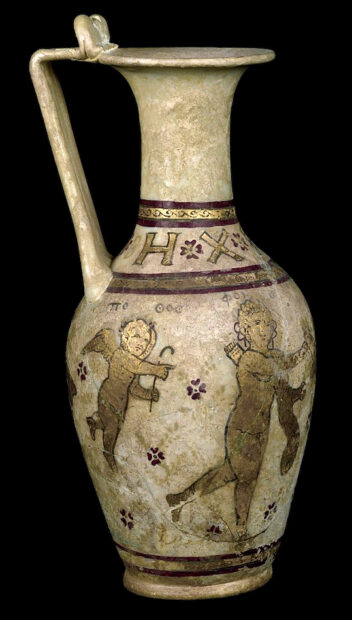
The Daphne Ewer, probably from Antioch, c. 175-225, blown glass, cold painted and gilded, 22.2 cm x 9.5 cm, Corning Museum Of Glass, Corning, New York. Photo source: Corning Museum of Glass.
This ewer, which is as unique as it is famous, depicts all four protagonists in three scenes. Found in a tomb at Kerch (ancient Panticapaeum, now Ukraine), it was likely made in Antioch, the capital of ancient Syria (present-day Turkey). J. P. Morgan was one of its former owners. The identifying Greek letters beside each character’s head point to Eastern sources, rather than Ovid. The 4th-century orator Libanius, who lived in Antioch, wrote that Apollo chased Daphne to the river Ladon in Daphne (a suburb of Antioch). After Daphne became a tree, the exasperated Apollo shot arrows into the ground. According to legend, king Seleucus I Nicator found the inscribed arrows, named the locale Daphne, and built a sanctuary on the site.
A Greek letter on the ewer identifies the chubby culprit Pothos (the brother of Cupid/Eros), who incites a very feminine-looking Apollo, who carries a laurel branch.
Daphne’s lower body turns into a laurel tree with four leafy boughs, while her upper body remains human and her arms are in an intermediate state of metamorphosis.
In the final scene, the river god Ladon sits on a rock and grasps his horn of plenty.
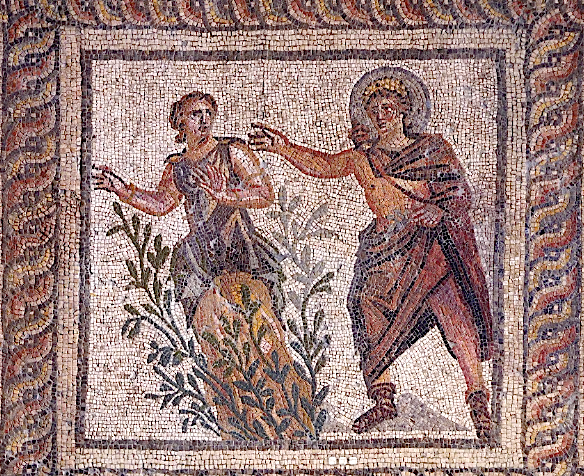
Apollo and Daphne mosaic, late 3rd century, stone, 42 1/8 x 41 5/16 inches (figured panel); 74 13/16 x 233 1/16 inches (complete work), from Daphne, Antioch (present-day Turkey), Princeton Art Museum. Photo source: Princeton Art Museum.
Along with Rome, Alexandria, and Constantinople, Antioch was one of the four major cities of the late classical world. As noted above, local myth set the Daphne story in an Antioch suburb. The makers of this mosaic exerted little effort to manifest Daphne’s transformation. Instead, the poor maiden seems to have been tossed into a bush. As Frances F. Jones (“Antioch Mosaics in Princeton,” Record of the Art Museum, Princeton University, 1981) notes, Apollo, who is garbed “in the imperial dress of the later Roman emperors,” has a nimbus that anticipates the Christian halo.

Emperor Phillip 1 coin, with Daphne on the obverse, c. 244-249, Damascus, coin trade. Photo source: vcoins.com / Athena Numismatics.
Gabriela Bijovsky published a coin from the reign of Volusian (Roman emperor from 251-253), which was discovered in excavations at Banius, Syria. It features a much-eroded image she identifies as Daphne on the obverse (“The Myth of Daphne on a Coin Minted at Damascus,” American Journal of Numismatics, 2003). Coins with a similar obverse image have surfaced, one of which is illustrated above. Bijovsky says the growths held by Daphne in ancient images are “usually unidentifiable,” though they can sometimes be distinguished as laurel, olive, or as vines. She also notes that Coptic images of Daphne have very similar compositions (two examples are discussed below).
Kevin Butcher has located a number of other coins with this image, and even a reference to it in Fernand de Saulcy’s numismatic study from 1874. He believes the female figure is grasping grape vines, and since some sources place Dionysus in the vicinity of Damascus, Butcher identifies the image as Ambrosia, who was metamorphosed into a grape vine (“Ambrosia in Damascus?,” The Numismatic Chronicle, 2010). Laurels have berries, and given the imprecise rendering of flora in this period, Bijovsky’s identification is plausible.
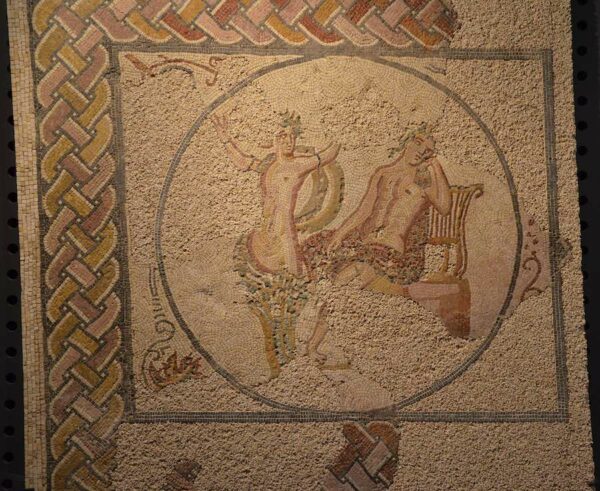
Apollo and Daphne mosaic, from the Villa Torre de Palma near Monforte, 3rd-4th century A.D., National Archaeology Museum of Lisbon, Portugal. Photo source: Carole Radatto / Wikimedia Commons.
In Roman times, this site in Portugal was part of the province of Lusitania. Daphne is turning into a tree. Her torso seems to emerge from a small, rudimentarily branching tree stump. She has laurel leaves on her head and her arms are outspread as she looks towards Apollo, who is seated before his lyre. He, too, has laurel leaves on his dejected head, but he looks away. Can he not bear to observe the metamorphosis? Or does this represent Apollo after the transformation is complete, when there is nothing to be done but sit beside a tree in melancholy frustration?

Apollo and Daphne, 5th-6th century A.D., Coptic ivory relief from Egypt, Ravenna, Italy, National Museum. Photo source: University of Bologna / Byzart.
As discussed above in connection with Roman wall painting, Knox posits a lost literary account of a “Song of Apollo” in which Apollo wooed Daphne with song before he chased or assaulted her. Knox believes this ivory shows Apollo singing to Daphne, and is thus another artistic manifestation of that lost literary tradition.
The beginning and the end of the story are collapsed: Cupid, in the upper left, initiated this doomed scenario; Daphne, on the right, is already up a tree, with one branch echoing the curve of her left hip and leg. Apollo’s right leg is turned away from Daphne. He leans away, his head against the left edge of the panel. This balances Daphne’s position. It perhaps also signals an early point in the narrative, when the singing god has not yet given chase. Could the goose symbolize the disguised Zeus/Jupiter’s successful rape of Leda, in marked contrast to Apollo’s unsuccessful pursuit of Daphne? Finally, is Daphne offering something to Apollo? The hole above her hand could have anchored a lost attachment.

Apollo and Daphne, detail of a panel from the “Shawl of Sabine,” c. 6-7th century, wool on linen textile, from Antinoë, Egypt, Louvre Museum, Paris. Photo source: Louvre Museum.
This fragment of a Coptic textile shares commonalities with the relief discussed above. Daphne is placed inside a tree with two main branches. Symbolically, they guard and preserve her virginity, converting her metamorphosis into a moral miracle akin to a still-living martyrdom. She grasps one of these branches with her left hand, and extends a very elongated right arm in Apollo’s direction. She holds a perfectly cruciform red flower, signaling her allegiance to Christianity and to Christ’s passion. The gesture could be apotropaic, similar to how someone might wave a cross at a vampire, though Copts generally feared demons and the ever-present evil eye. The flower might signal Daphne’s safety from Apollo’s rapacious advances. It could conceivably be a token of conversion offered to Apollo.
The chi-rho (the superimposed first two letters of Christ’s name in Greek) pendant that hangs between her breasts is an undoubted Christian emblem that amplifies and confirms the symbolism of the cruciform flower. Apollo, meanwhile, pulls an arrow out of his quiver. Apollo’s lyre is on a stand, and a second, smaller laurel tree bends across it at a 90-degree angle, which serves to miraculously decorate the stand with laurel leaves from a still-living tree. The presence of the lyre could connect this work to Knox’s posited “Song of Apollo.”
In The Age of Spirituality: Late Antique and Early Christian Art (1979), William A. P. Childs says the “composition” of the ivory plaque and the shawl are “not appropriate to the event.” He thinks the “classical theme has gradually lost its meaning” and isolated scenes are juxtaposed for no particular purpose in the textile. (Click here for other photos of the shawl.) Childs fails to consider that classical themes can take on new meanings, and can be mixed with other content that the owners and makers of such objects regarded as appropriate. The Apollo and Daphne story has clearly been made into an allegory of chastity. The other classical figures could also be imbued with new meanings, or they could subsist with Christianized images. Both Apollo and Diana (in the adjacent panel) draw arrows. While Apollo’s triumph over the Python could be read as a prefiguration of triumph over the Christian devil, Apollo and Diana could simply be included on this garment as powerful, luck-bringing guardian figures: one kills demons, the other provides fresh game.
However befuddling to modern viewers, these images were conveyers of beneficent symbolism that brought magical rewards. Henry McGuire (“Garments Pleasing to God: The Significance of Domestic Textile Designs in the Early Byzantine Period,” Dumbarton Oaks Papers, 1990,) points out that Nile River imagery — like the “putti fishing from boats, waterfowl, and lotus plants” on the Sabine shawl — were “imbued with the power to attract wealth and abundance.” He also notes St. John Chrysostom’s condemnation of the practice of wearing charms inscribed with the names of rivers as lucky amulets. The iconographies of domestic Byzantine textiles differed from those found in contemporary churches. McGuire explains that they had different purposes: these household objects were “closely intertwined with magic” and concerned with prosperity and security; church and manuscript images, on the other hand, emphasized instruction and the promulgation of dogma. Nilotic themes, heroic pagan narrative, and Christian imagery were densely and deliberately interwoven into these textiles.
Renaissance and Later Works

Apollo and Daphne illumination from Christine de Pizan, L’Epistre d’Othea, Paris c. 1410-1414, Harley Manuscript 4431, fol. 134v, British Library, London. Photo source: British Library.
Popularly referred to as The Book of the Queen, this illuminated manuscript was assembled by Christine de Pizan for Isabeau of Bavaria, Charles VI of France’s queen consort. The entire manuscript is digitized and can be accessed here.
In this illumination, the woman-as-vessel typology is pressed to the extreme. Daphne resembles a human planter: her lower portion is human, while her top is arboreal. The dandyish god — whose sole traditional attribute is the laurel — sports particularly luxuriant sleeves as he carefully plucks leaves that he fashions into a wreath.
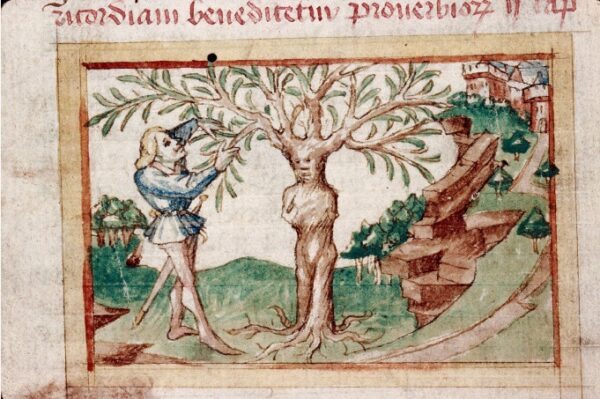
Apollo and Daphne, illumination from Christine de Pizan, Epitre d’Othea, c. 1460, ms. 0391 (f. 086v), Bibliothèque municipale, Lille. Photo source: French Government / Wikimedia Commons.
Daphne is rough-hewn and schematic, like a cheap figure outside of a cigar store crudely carved out of the trunk of a tree. Apollo has tights and a sword instead of the classic cloak and a bow. Space is dramatically collapsed on the right side, leading to a tiny-looking hilltop castle. For the rest of the codex, go here.
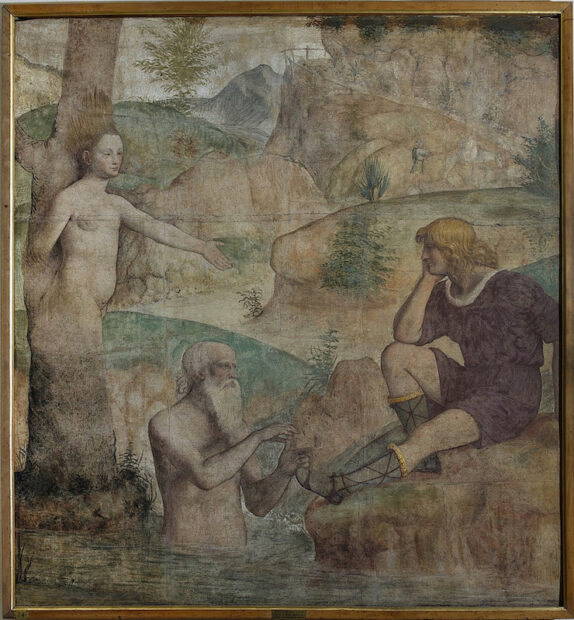
Bernardino Luini (c. 1480/82-1532), Apollo, Daphne and Peneus, c. 1521 – 1523, detached fresco from the Villa Peluca mounted on canvas, 167 x 156 cm., Brera Picture Gallery, Milan. Photo source: Engramma.It.
Luini dispenses with symbolism. Apollo, attired in a simple Renaissance costume, has no bow, no arrows, no lyre, and no halo. Oddest of all, he has no laurels, though he had vowed to perpetually adorn his head, lyre, and bow. Nothing identifies this man as the mighty god Apollo. He could be a youthful shepherd, or the son of the man in the background, who is driving a loaded donkey up a winding road. This wistful and meditative youth looks out at a tree, his head cupped in his right hand.Go here for a 4th century B.C. coin from Delphi that shows Apollo (with a laurel branch) seated in the same pose.
The old man in the river could be taking a bath, or volunteering to remove the youth’s footwear. He lacks the full head of hair, the curly beard, the reed crown, and the water jug that commonly identify a river god. Nor does he recline in characteristic river god fashion, since rivers rest upon the earth. Daphne, for her part, is a ghostly, wholly human, one-armed apparition — that is, to the extent that she is whole. No branch buds or roots sprout from her extremities. The tree, in fact, is so big that we see little more than its trunk. We would never call it a laurel without her presence. Daphne and the old man make mysterious gestures that, in conjunction, seem to say: “you made this happen.” This young man has been — and will be — there on the riverbank for a long time. Is he the eternally youthful Apollo, who habitually returns to this spot, where he reflects on his lost love and hallucinates the other two figures that long ago vanished into bark and bubbling brooks? Or is he just an ordinary young man who dreamily figures his lost love in the myth of Apollo and Daphne?
Though dramatically stripped of emblems, the Luini has much in common with meditative Roman era renderings of the myth, such as the mosaic from the Villa Torre de Palma. Was Daphne meant to be a literal presence in that mosaic, or is she manifested out of Apollo’s thoughts, where she is always present? This could explain why Apollo looks away, and why he already has a laurel crown (though he is often conventionally represented with the latter, even before Daphne has turned into a tree).
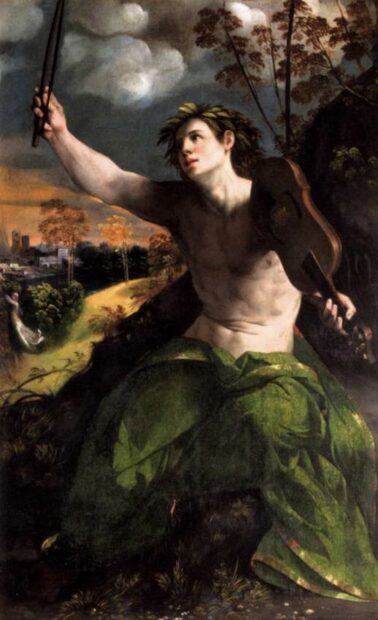
Giovanni Luteri, known as Dosso Dossi (1489-1542), Apollo and Daphne, c. 1525, oil on canvas, 191 x 116 cm, Galleria Borghese, Rome. Photo source: Web Gallery of Art / Wikimedia Commons.
Under a turbulent sky that lends the painting a dramatic, tragic air, a laurel-crowned Apollo dramatically raises his bow while playing his viola da braccio. At that very moment, the miniscule figure of Daphne vanishes into a stand of trees on the far left of the painting. An anonymous Italian print also features a similar image of Daphne (after Parmigianino) in the corner of an image with four cupids. Apollo’s muscular torso is based on the Belvedere Torso, one of the most highly prized antiquities in the Vatican Museum (like the Apollo Belvedere and the Laocoön discussed in Part 1). This painting came to the Borghese from Cardinal Luigi Capponi, via Cardinal Ludovico Ludovisi, and it may have previously belonged to Cardinal Scipione Borghese, who commissioned Bernini’s Apollo and Daphne.
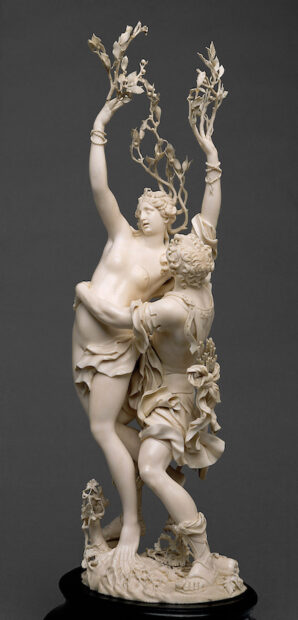
Jakob Auer (c. 1645-1706), Apollo and Daphne, before 1688, ivory statuette, 43.9 cm high, Kunsthistorisches Museum, Vienna. Photo source: Kunsthistorisches Museum.
Ivory is a substance that enables wire-like traceries, translucently thin forms, and detailed, billowing draperies, sometimes with elaborate, finely tied bows, as in this example. In Part 1, I suggested that delicate details in Bernini’s large marble Apollo and Daphne could have been inspired by ivory carving. Here Auer returns the favor. While the fragile forms emanating from Daphne’s hands and hair unambiguously reference Bernini’s sculpture, their whispery thinness is beyond anything that can be rendered in marble. Auer even differentiates every tiny fletched arrow in Apollo’s quiver.
Bernini prioritizes drama. He rendered quasi-cinematic states: chase, capture, transformation, and impending collision. Auer’s relatively static composition, by contrast, delights in teasing out and exploiting the supple and elastic properties of his medium.

Jakob Auer, Apollo and Daphne, detail of Apollo’s hands on Daphne’s midsection. Photo source: Giulio Nepi, flickr.
Auer’s Apollo is trying to hoist Daphne, just as Bernini’s Pluto did to Proserpina. One can see in the detail that his hands press into female flesh, in much the same manner as Pluto’s hands. As noted in Part 1, Bernini referenced a lost work by the Greek sculptor Cephisodotus. Here Auer refers to Bernini’s Pluto and Proserpina, the first great marble sculpture of the Baroque. Auer also pays homage to Bernini in Daphne’s rooted toes, and in the manner she rises upward during her metamorphosis.
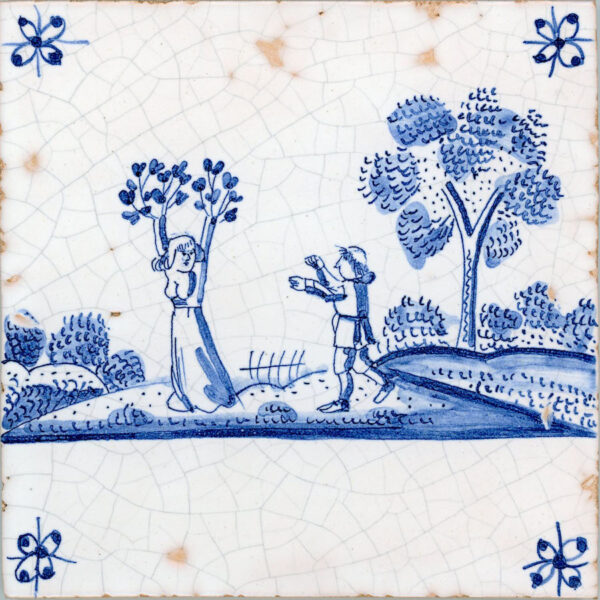
Dutch Tile, Apollo and Daphne, c. late 17th to early 18th century, faience, tin glaze, cobalt oxide, 5.1 x 5.1 inches (13 x 13 cm), art market. Photo source: Douglas Watson Studio.
Apollo and Daphne was a popular subject produced by workshops in several Dutch cities that manufactured tiles. They were also popular exports: a tile in the Hermitage Museum was found during restoration work on the Menshikov Palace in the 1960s-1970s.
The corners of this tile have cross-and-flower motifs that were utilized in Harlingen workshops. Its simple, schematic forms result in fortuitously heart-like leaves that crown Daphne’s branches. Apollo’s head is perplexing: is he wearing a hat or a laurel wreath, or is he meant to be tonsured? Did the Apollo and Daphne theme have regional significance? I posed these questions to Maaike Dirkx, an Amsterdam-based art historian and researcher. She replied: “In the Hermitage [example] the man is definitely wearing a rudimentary laurel wreath. I doubt that tile makers were so sophisticated as to know the full story. I assume they copied the image from each other. I don’t know if it had any special significance other than a great excuse to show Daphne’s exposed breasts.” There can be many reasons, indeed, that endow an old myth with new life.
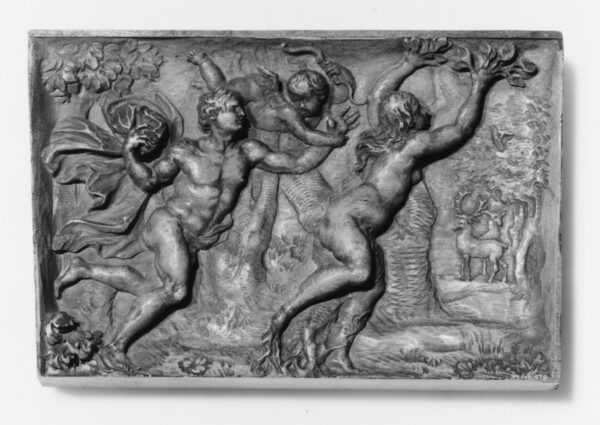
workshop of Andrea Brustolon (1662–1732), Apollo and Daphne, c. 1720-30, hardwood (probably boxwood), 4 9/16 × 7 1/16 inches, Metropolitan Museum of Art. Photo source: Metropolitan Museum.
This miniature relief is noteworthy because an inordinately supple Cupid in the sky directly grasps Apollo’s left wrist. Cupid, of course, both impels and impedes Apollo’s passion for Daphne, who is already turning into a tree. The stag and the doe in the right background represent a presumably happier couple. More ominously, they prefigure another tale from Ovid’s Metamorphosis, that of Diana and Actaeon, wherein Actaeon is transformed into a stag and devoured by his own hunting dogs.
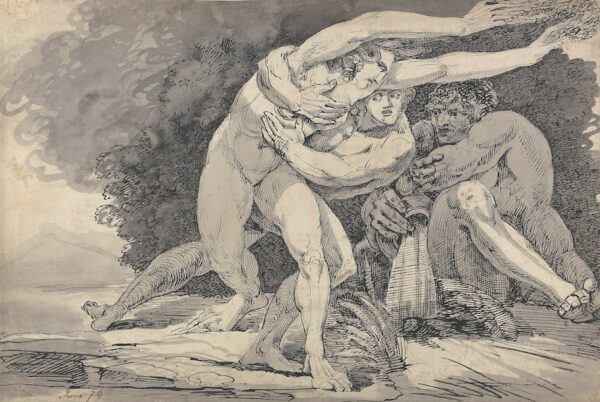
“Master of the Giants,” probably James Jefferys (1751-1784), Apollo and Daphne, 1779? Pen and black ink with gray wash and graphite, 14.13 x 20.98 inches, inscribed in pen and brown ink lower left: “June 79”; inscribed on back in graphite lower right: “Prince Hoare the Younger (‘The Master of the Giants’)”; Yale Center for British Art, New Haven. Photo source: Google Art Project / Wikimedia Commons.
Jefferys’ artistic persona was not defined very clearly until the 1970s. New discoveries permitted his connection to many drawings in a now-dispersed album referred to as the “Master of the Giants Album.” As noted in the vintage inscription above, Prince Hoare was among those mistakenly identified as the Master of the Giants.
Jefferys was an English artist who was part of a group of artists associated with Henry Fuseli in Rome in the 1770s. His preference for hulking figures shows in this work. A casual viewer may be surprised to learn that the figure in the foreground is a woman. Her right foot is just starting to sprout roots and embryonic branches are issuing from her outstretched arms. The pointing river god in the background further confirms her identity as Daphne. Yet Jefferys’ Apollo and Daphne could easily be mistaken for a pair of struggling wrestlers. The myth is illustrated by two grappling figures in a number of Pompeian frescoes referenced above by Knox, and in the Cecco Bravo treated in Part 1.
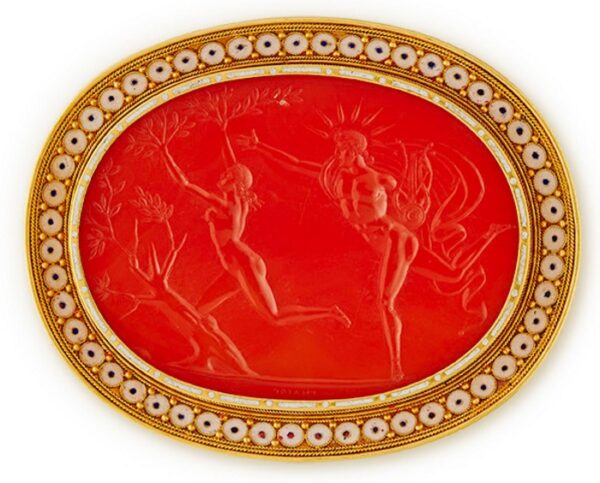
Daphne Fleeing Apollo, signed: ΓΝΑΙΟΣ (Gnaios) [falsely], Rome, c. 1800, orange carnelian intaglio, gem: 5 x 3.8 cm., art trade. Photo source: Wartski.
Apollo and Daphne are sprinting in full Ovidian flight. Apollo’s drapery coils behind him as if it were a recently untied ribbon. He reaches for Daphne with his right hand, just as branches grow out of her arms. The expressively anthropomorphic tree in the left foreground offers a mute foretaste of her imminent fate. Phillips Brothers & Sons mounted the brooch with antique-style enameled disks and gold wirework and beading by c. 1860, decades after the death of Poniatowski.
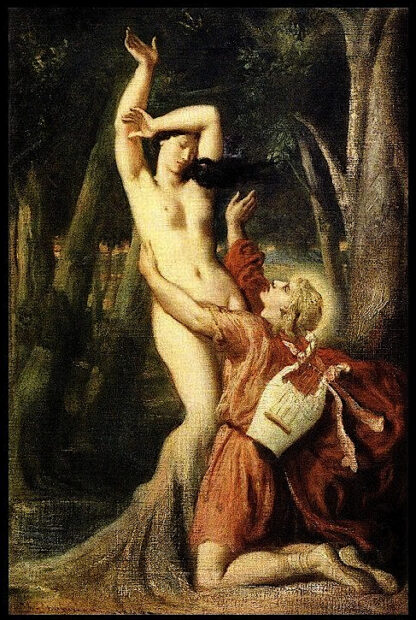
Théodore Chassériau (1819-1856), Apollo and Daphne, 1846, oil on canvas, 53 x 35 cm, Musée d’Orsay, Paris. Photo source: tumblr.
In Chassériau’s painting, a very muscular Daphne has begun her transformation, but only from the knees down. She is pushed upward, as her lower extremities merge with the rooted base of what will become a very large tree. Apollo is on his knees, in a pose of absolute reverence and adulation. He grasps her torso with his left hand, and he reaches up to touch her hair with his right hand (as noted in Part 1, Ovid’s Apollo is obsessed with Daphne’s hair). Daphne’s upper limbs are raised, already branching toward the sky. She leaves the human condition in a trance-like state.
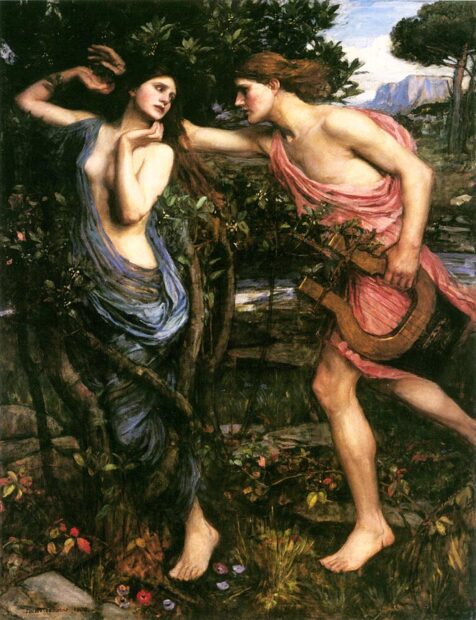
John William Waterhouse (1849-1917), Apollo and Daphne, 1908, oil on canvas, 57 x 44 inches, private collection. Photo source: allartpainting / Wikimedia Commons.
Born the year the Pre-Raphaelites gained notoriety, Waterhouse emerged as a conventional history painter. He gradually metamorphosized into a dreamy, Pre-Raphaelite-style painter of myth, with a strong proclivity for Ovid and pale, fragile-looking femme fatales. In this painting, Daphne’s left foot is frozen in mid-flight, literalizing a couplet from Ovid:
… when her feet she found
Benumb’d with cold, and fasten’d to the ground
Though fully human, Daphne is ensnared by branches that resemble an enormous, clam-shaped bear trap. She is the spitting image of numerous entrapping Waterhouse nymphs, sirens, and sorceresses, such as the bevy of fatal beauties in Hylas and the Nymphs (1896). As Victorian women struggled for their rights, male artists portrayed alluringly malevolent, deceptively dangerous women garnered from myth, as if to prove that women with agency had always been deadly. But in Apollo and Daphne, the consumptive-looking nymph is herself entrapped: she will soon be consumed by the tree that becomes her.
As Daphne turns toward Apollo, her expression seems more wistful than fearful. He reaches out for her upraised right hand. She resembles the psychologically ambiguous Waterhouse melancholics that seem a wee bit sad they are about to kill an innocent adolescent. Maybe she is having second thoughts. Perhaps Apollo is not so bad. Maybe life with him beats being tangled up in bushes for eternity.
Waterhouse’s enraptured Apollo is youthful, effeminate, and not very muscular. He’s more a skinny hippie than an athletic god. Apollo brings his lyre, which already seems to be crowned by laurel leaves from a shoot cast off from the living tree — a detail also present in Sabine’s shawl.
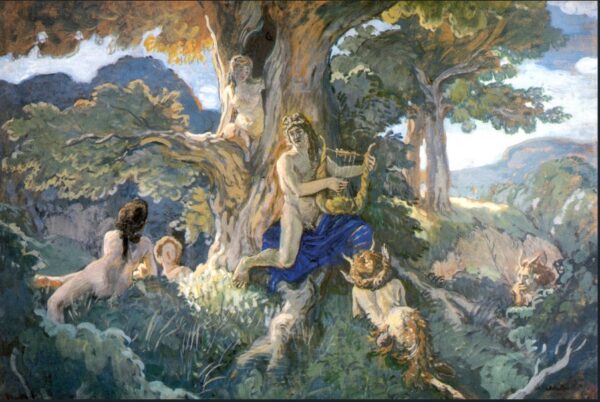
Alexandre Benois (1870-1960), Apollo and Daphne, 1908, gouache on cardboard, 70 x 103 cm, State Russian Museum, Saint Petersburg. Photo source: WikiArt
Benois, a Russian artist, critic, editor, and curator, co-founded the magazine Mir iskusstva, which gave rise to the Ballets Russes, for which he became a stage designer. He bridled against Russian realism and academic art. Here he renders a colorful, loosely painted version of Apollo and Daphne that owes much to Bonnard’s technique. Seated on what looks like a mighty oak tree (a true laurel is a bush or shrub), Apollo plays his lyre, which has attracted and becalmed the nymphs and satyrs in the foreground. Daphne emerges, seemingly birthed from a vaginal-like opening in the tree. Likewise enchanted by the god’s music, she looks on approvingly.
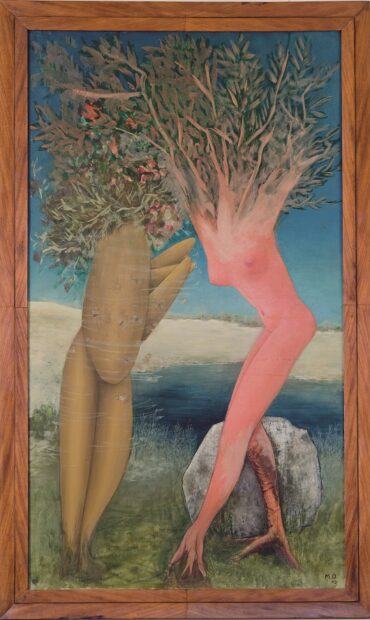
Meret Oppenheim (1913-1985), Daphne and Apollo, 1943, oil on canvas, 140 x 80 cm, Lukas Moeschelin collection, Basel, Switzerland. Photo source: Museum of Modern Art, Lille.
No 20th century art movement was more concerned with metamorphosis than Surrealism. Many Surrealist-influenced artists — especially women — merged plants and people. In Oppenheim’s Daphne and Apollo, currently in the Fantastische Frauen exhibition at the Schirn Kunsthalle in Frankfurt, both figures are undergoing transformations. The pink, emphatically female form on the right is clearly Daphne, who is sprouting a thick growth of green laurel foliage from her arms and upper body. One can still make out a ghostly head between what had been her neck and her left arm. Apollo’s body, which is russet brown (his trunk even resembles a potato), has been remade in a pictorial language derived from Picasso’s work from the 1920s and 1930s. The foliage that erupts from his upper extremity evidently contains flowers, though they are eclipsed by laurels. A head with an open mouth — discernible just above Apollo’s arms — appears to look at Daphne. Its blurry, collage-like construction echoes the “accidental effects” that the Surrealists cultivated in order to break away from consciously controlled activity. Additionally, its ambiguity and seemingly provisional nature heighten the illusion of continuous transformation.
Juliet Jacques (Schirn Kunsthalle magazine) notes what Oppenheim called the “androgyny of the mind,” including her Jungian belief that any significant work “invariably reflects the entire human being, which is both male and female.” When Daphne and Apollo was shown in the What We Call Love — From Surrealism to Now exhibition at the Irish Museum of Modern Art in 2016, the brochure by Alicia Knock noted: “Meret Oppenheim’s works escape categorical definitions in favor of open-ended readings. A man, a woman, an androgynous person or the artist herself, the viewer understands that art should be endlessly admired, interpreted and desired, just like love.”
In Daphne and Apollo, “Apollo” is no longer Apollo, but rather a being subject to species fluidity and, apparently, gender fluidity as well. Rather than fleeing Apollo, Daphne faces him, and even bends her upper body in Apollo’s direction. The painting’s message seems to be that this new, evolving creature is attractive precisely because it is less like Apollo, the male ideal. Recall also that Daphne had foresworn the company of men altogether. Moreover, in the earliest surviving version of the myth, she and her maidens had murdered Leukippos when they discovered that he had been impersonating a woman.
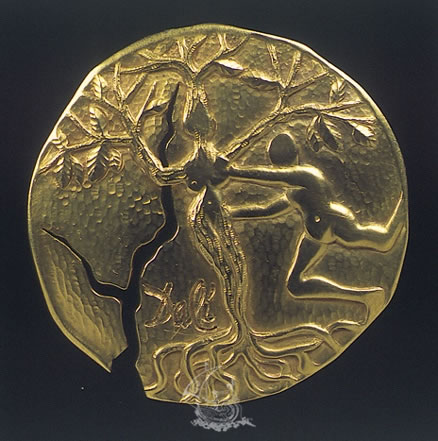
Salvador Dalí (1904-1989), Daphne and Apollo, 1953, 18 karat yellow gold medal, 4.6 x 4.6 x 1.2 cm, Gala-Salvador Dalí Foundation. Photo source: Salvador-dali.org.
Dalí renders Daphne like a curvaceous mermaid — but with roots instead of a fish’s tail. The sprouting branches are somewhat reminiscent of those in the antique-styled carnelian intaglio illustrated above. Dalí’s medal is cracked, and it shows signs of heavy wear, especially on the faces, which are eroded away. Dalí’s fiction is that his medal — like the Damascus coin treated above — is a precious archaeological relic from a time when myths were the core of a system of deeply held beliefs, rather than mere sources of images to grace the back of a coin. A 1952 gouache on cardboard study for this and four other jewels is in the collection of the Gala-Salvador Dalí Foundation.
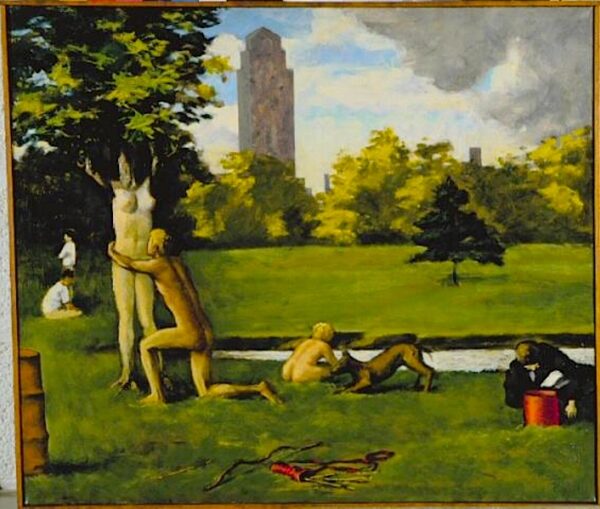
Milet Andrejevic (1925-89), Apollo and Daphne, 1969, oil on canvas, 24 x 28 inches, Rhode Island School of Design Museum, Providence. Photo source: Rhode Island School of Design.
Born in Yugoslavia and trained at the Belgrade Academy of Fine Arts, Andrejevic moved to Paris in 1952 and relocated to New York City in 1958. His most highly regarded works treat Greek myths set in Central Park. In Apollo and Daphne, he is channeling early Cézanne and Manet, with an admixture of Bellows, but with the static formality and paradoxical juxtapositions found in the work of Puvis de Chavannes and Seurat. Andrejevic created friezes of modern life, skyscrapers and all. Ovid has come to life in Central Park. Casual pagan nudity coexists with a cropped trash barrel, near to which Apollo has left his bow and arrows. Apollo grasps Daphne, while her feet are springing roots, and her head and arms have already burst into a sizeable tree — similar to the planter-like Daphne in the British Library manuscript. The god’s kneeling reverence recalls that of Chassériau’s Apollo. But anonymous office workers have replaced shepherds in arcadia, and an attentive dog apparently thinks metamorphosis is a very neat trick, indeed. Perhaps it will be the first to mark its territory on the new tree.
A 1981 gallery exhibition devoted to Andrejevic included titles such as The Three Ages of Man, Diana and Actaeon, and West Side View With Fall of Icarus. In his review of this exhibition, Hilton Kramer noted the mythic qualities these paintings possess:
“His figures may be attired in running shoes, T-shirts … Yet … the atmosphere is Arcadian and mythic, and the attitude is allegorical … They represent … the abstractions of childhood, youth and age — stages in the timeless cycle of life — rather than figures specifically of our time.”
In a manner comparable to Seurat’s bathing and park scenes, Andrejevic’s figures are simultaneously of our time, and not of our time. I seldom agree with Kramer, but he was right to say Andrejevic deserved a large-scale public commission in a contemplative place, such as a library. Imagine an ensemble of mythological scenes with the skyline of New York from the four sides of Central Park as a backdrop.
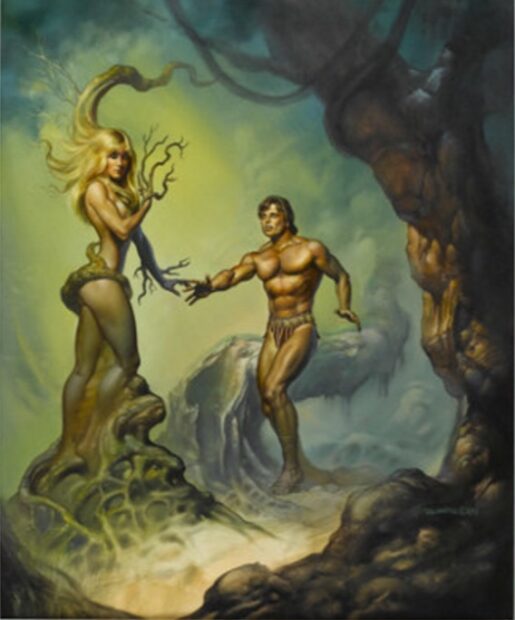
Boris Vallejo (b. 1941), Daphne and Apollo, 1989, oil on board, 24 x 20 inches, art trade. Photo source: Heritage Auctions.
Vallejo is a Peruvian-born hyperrealist fantasy painter. His Daphne and Apollo can be taken as proof that Arnold Schwartzenegger is indeed a god. Vallejo has taken the former California governor’s Conan the Barbarian (1982) persona back in time (Terminator-style), to when the earth was young, and Apollo glimpsed his first love.
But Conan/Apollo is too late to catch the blond Daphne (Sandahl Bergman, the warrior queen Valeria in Conan) he has been chasing. Moreover, she already has a gnarly branch growing around her bush, which forms an organic chastity belt. In this situation, even the son of Zeus can do nothing more than flex and vogue — like the iron-pumping muscle man that he is — and receive a wooden hand-shake instead of a kiss. Though Apollo has lost Daphne, he will never forget her.
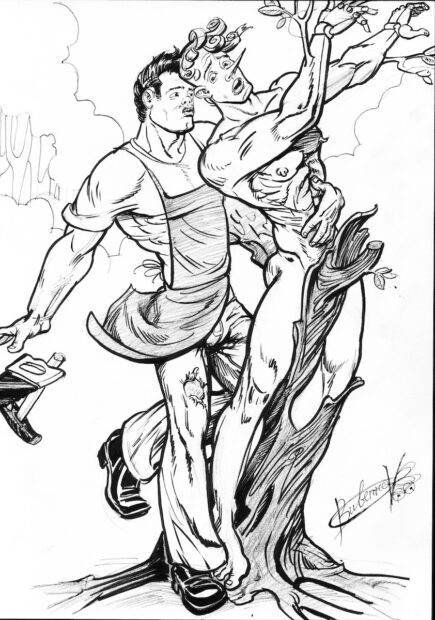
Ivan Bubentcov (b. 1972), Apollo and Daphne, c. 2018, mixed media on paper, 16.5 x 11.5 inches, collection of the artist. Photo source: Adonis Gallery.
Born in a town near Moscow in 1972, Ivan Bubentcov is a graduate of the Abramtsevsky Art-Industrial College (1992) and the Moscow State Art and Industry Academy (1999), where he received academic training. He cites Russian artists in the realist tradition as influences, including Alexander Ivanov (1806-1858), Konstantin Somov (1869-1939) and Ivan Bilibin (1876-1942). The latter — like Benois — contributed to Mir ishkusstva and was a designer for the Ballets Russes. But Bubentcov’s greatest influence is clearly Touko Valio Laaksonen (1920-1991), better known as Tom of Finland, who created hyper-masculine homoerotic illustrations.
Bubentcov, who still lives in Russia, primarily makes mixed-media works on paper with pencil, ink, wash, felt tip, and pastel. He depicts “gay life in Russia,” with heroes who are “a little naive, simple, but very attractive.”
Bubentcov’s Apollo and Daphne is actually a synthesis of the Pygmalion and the Apollo and Daphne myths from Ovid’s Metamorphosis. The figure of Daphne is taken from Bernini’s sculpture, though here Daphne is male. In place of Apollo, Bubentcov has inserted a hulking male sculptor, who wears an apron. His right hand is outstretched like Bernini’s Apollo, but only because the sculptor has discarded his hammer and wood saw. He grasps Daphne’s muscular stomach with his left hand (rather than the encasing tree trunk that Bernini’s Apollo had grasped). The sculptor appears to be pursing his lips, as if he is about to kiss Daphne, who is clearly fashioned from wood. (His curly hair recalls wood shavings.) The sculptor is clearly meant to be Pygmalion, who had fallen in love with his ivory statue. As he kissed her, warmth entered her body: she came to life and became Pygmalion’s bride. Ovid’s Daphne, on the other hand, recoiled when Apollo kissed her encasing bark. Whereas Apollo’s efforts were rewarded with nothing but leaves, Pygmalion’s fondest dream came true. Bubentcov’s Daphne looks stiff and wooden, but multiple kisses will breath life into him. Bubentcov has included several humorous elements. Daphne’s long, sharp nose recalls another wooden being who became a person: Pinocchio. This detail implies that Daphne’s aversion to Apollo/Pygmalion is feigned. Furthermore, Daphne’s oval mouth recalls the schematic mouths of inflatable love dolls and thereby signals receptivity as well as the sculptor’s preferences. Finally, right at the level of Daphne’s crotch, a branch extends from the tree trunk. Daphne’s got wood. This detail recalls Albrecht Durer’s The Bath House (1496), in which a spigot that emanates from a wooden plank is juxtaposed in front of a male bather’s crotch.
How can we rationalize Pygmalion’s usurpation of Apollo’s position? Pygmalion presumably intended to sculpt the figure of Apollo separately, but became so overcome by Daphne’s beauty that he rushed in to kiss the sculpture, thereby assuming the pose of Bernini’s Apollo — albeit very temporarily — en route to many future happy endings.
Finally, we return to the very notion of laurels, which, as noted in the discussion of the Greek pot at the beginning of this essay, preceded the myth of Daphne. Andrew Marvell, in his poem “The Garden” (1681), expresses amazement at the human obsession with winning laurels:
How vainly men themselves amaze
To win the palm, the oak, or bays,
And their uncessant labours see
Crown’d from some single herb or tree
****
My thanks to Luca Frigerio for providing a good image of the Luini.
****
Ruben C. Cordova is an art historian and curator. His last exhibition was “The Day of the Dead in Art” at Centro de Artes in San Antonio (2019-2020).


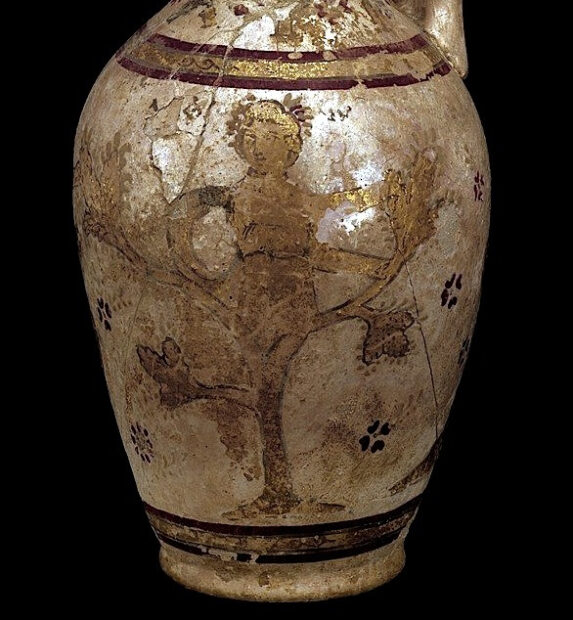


2 comments
Awesome!
Thank you very much for this wonderful work Ruben C. Cordova! I am surprised how accurately and scrupulously the whole myth of Apollo and Daphne has been analyzed! And how subtly and precisely the meaning that I put into my drawing is understood!
Thank you very much again!
Ivan Bubentcov
You are most welcome, Ivan. Your work was a wonderful way to end the article since it is a very contemporary work that–at the same time–engages with the art of the part.